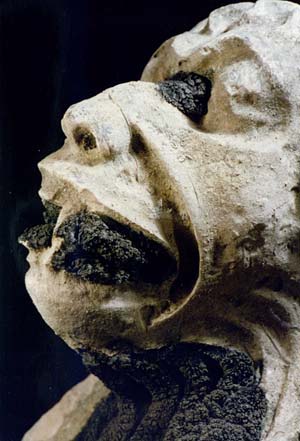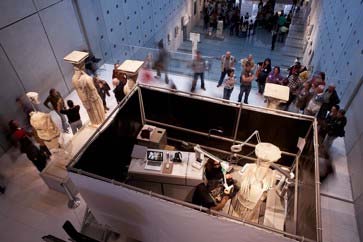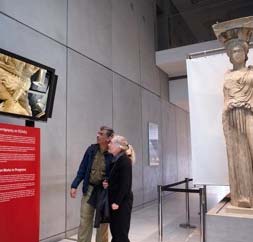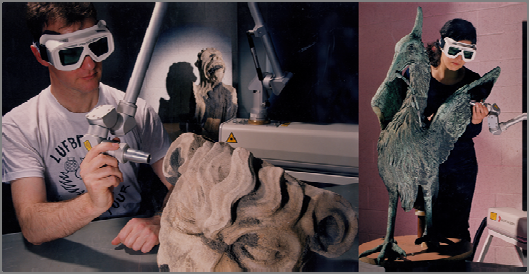Laser cleaning leads to the preservation and restoration of world heritage and art
Submitting Institution
Loughborough UniversityUnit of Assessment
PhysicsSummary Impact Type
TechnologicalResearch Subject Area(s)
Chemical Sciences: Macromolecular and Materials Chemistry, Physical Chemistry (incl. Structural)
Engineering: Materials Engineering
Summary of the impact
Laser cleaning is now a standard technique of great value in the
conservation process to which research conducted at Loughborough
University made a significant contribution. This work played a major part
in introducing laser cleaning to conservators across Europe and further
afield and was instrumental to the preservation and restoration of world
heritage sites such as the Acropolis at Athens and important works of art
including pieces by Henry Moore and Jacob Epstein. In addition to the
cultural impact, the availability of laser cleaning techniques has:
improved public services and understanding of, and engagement with, the
conservation process (live restoration of artefacts); improved health (of
restoration workers); influenced conservation practitioners (through an
enhanced skill-set).
 Partially cleaned gargoyle of Lincoln Cathedral
Partially cleaned gargoyle of Lincoln Cathedral
(source: PhD Thesis M.I. Cooper, 1994)
Underpinning research
Research conducted at Loughborough University from 1993 into the early
2000s by Martin Cooper (90-94), Christopher Cottam (94-98), Paraskevi
Pouli (95-2000), Claire Madden (95-2000), Ian Sutherland (presently
Lecturer in Chemistry at Lougborough), Schiffers (94-98), David Sheerin
(89-94) and others under the leadership of Professor David Emmony sought
to understand the underlying processes through which lasers could be used
as a cleaning tool.
Laser cleaning offers a radically different approach to cleaning items
made from a wide variety of materials such as: marble, limestones,
sandstones, terracotta, alabaster, plaster, aluminium, bone, ivory and
vellum. The precision of laser cleaning means that the technique goes
beyond restoring aesthetics but also to revealing problems that can affect
the long term survival of the pieces themselves. For this reason much of
the research carried out at Loughborough University focused on the use of
lasers to clean and preserve monuments, paintings and other artefacts.
Techniques developed by the Loughborough University group have been
applied to the restoration of historical, antiquated and artistic pieces
that are of great cultural and academic importance (see later).
- Much of the work carried out at Loughborough University focused on
laser cleaning as a precise tool for the cleaning of objects. It was
shown that lasers could be used to circumvent the severe damage of an
object's surface caused by traditional approaches to cleaning such as
using an air-abrasive or steam [3.1]. This work supported the
use of lasers as the preferred method to clean and preserve artefacts of
high intrinsic or cultural value.
- Characterisation of the effects of laser cleaning on limestone was a
specific contribution that led to the adoption of lasers as a tool for
cleaning and preservation historical monuments and other important stone
artefacts [3.2].
- The application of Q-switched YAG laser systems for laser cleaning
form a substantive part of the Loughborough University group's
portfolio. Demonstrating that the relatively low cost YAG Q-switched
lasers were suited to cleaning is a contributing factor to their wide
adoption in industry [e.g. 3.2, 3.3].
- The research addressed the removal of corrosion, polymers and paints
from a variety of surfaces as well as the effect of lasers on pigments.
Detailed studies were carried out on: discolouration, laser-induced
reduction, splashing and other "detrimental to surface effects" such as
the interaction of a laser-generated `bubble' with a boundary. This
research helped establish laser cleaning as a technique that could have
wide application, ranging from stonework through to parchment [e.g.
3.4, 3.5, 3.6].
- This research was underpinned using a variety of spectroscopic and
surface analysis techniques including: visual observation, reflectance
spectroscopy, X-ray diffraction, X-ray photoelectron spectroscopy,
X-ray powder diffraction analysis (XRD), transmission electron
microscopy, Mach-Zehnder interferometry and schlieren photography
techniques [3.1-3.6].
References to the research
3.1. R.P. Tong, W.P. Schiffers, S.J. Shaw, J.R. Blake and D.C. Emmony,
The role of 'splashing' in the collapse of a laser-generated cavity near
a rigid boundary, Journal Of Fluid Mechanic,s 380,
339-361 (1999). DOI: 10.1017/S0022112098003589 Comments: research paper
in an international journal [51 citations].
3.2. M.I. Cooper, D.C. Emmony and J. Larson, Characterisation of laser
cleaning of limestone, Optics and Laser Technology, 27(1),
(1995). DOI: 10.1016/0030-3992(95)93962-Q
Comments: research paper in an international journal [56 citations].
3.3. P. Pouli, D.C. Emmony, C.E. Madden and I Sutherland, Analysis of
the laser-induced reduction mechanisms of medieval pigments, Applied
Surface Science, 173(3-4), 252-261, (2001). DOI:
10.1016/S0169-4332(00)00909-0
Comments: research paper in an international journal [32 citations].
3.4. P. Pouli, D.C. Emmony, C.E. Madden and I. Sutherland, Studies
towards a thorough understanding of the laser-induced discolouration
mechanisms of medieval pigments, Journal of Cultural Heritage,
4(1), 271-275, (2003). DOI: 10.1016/S1296-2074(02)01207-4 Comments:
research paper in an international journal. Note: while not a physics
publication this is a subject leading international technical journal with
a five year impact factor of 1.366. This publication provides evidence of
impact outside of the discipline [10 citations].
3.5. C.A. Cottam, D.C. Emmony, A. Cuesta and R.H. Bradley, XPS
monitoring of the removal of an aged polymer coating from a metal
substrate by TEA-CO2 laser ablation, Journal of Materials
Science, 33(12), 3245-3249, (1998). DOI: 10.1023/A:1013212725052 [4
citations]. Comments: research paper in an international journal.
3.6. S.J. Shaw, W.P. Schiffers, T.P. Gentry and D.C. Emmony, The
interaction of a laser-generated cavity with a solid boundary, Journal
of the Acoustical Society of America, 107(6), 3065-3072, (2000).
DOI: 10.1121/1.429335
Comments: research paper in an international journal [19 citations].
Research Grants Obtained:
G3.1. 1-Oct-94 to 30-Sep-98 £16240, NG MUS on Merseyside Case.
G3.2. 1-Mar-97 to 31-Mar-98 £7350, Laser Ablation (UK Charitable
Bodies).
G3.3. 10/1/90 to 12/31/96, £6148 Victoria & Albert Museum Case
Award.
G3.4. 1/1/94 to12/31/95, £30388.62 EEC:Human Cap ERBCHRXCT930336.
G3.5. 1/1/94 to 9/30/94 £3251 EEC-Int. Scientific Cooperation.
Details of the impact
(1) Research carried out by the group led directly to the introduction of
the technique into the Sculpture Conservation department of the pioneering
Conservation Centre at National Museums Liverpool and to the development
of the UK's first commercially available laser cleaning system for
conservation in the `Phoenix Classic' Q-switched Nd:YAG system
manufactured by Lynton Lasers Ltd [5.1]. Lynton Lasers remains the
UK's leading supplier of laser cleaning systems to the heritage field,
having sold around 40 systems in the past 15 years to customers in the UK,
USA, Germany, Denmark, Poland, Australia, Singapore, South Korea and
Kuwait [5.1]. We note that laser cleaning has not replaced other
techniques, rather it extended the range of tools available to the
conservator [5.1]. The impact of this work is substantive as it
was disruptive to the discipline.
(2) preservation and restoration of world
heritage sites and of works of art.
Loughborough University PhD graduate Dr Martin Cooper, former head of
Conservation Technologies at National Museums Liverpool, applied the laser
cleaning technologies he helped develop at Loughborough University
(including work on the gargoyles of Lincoln Cathedral) to collections that
range from ancient Egyptian and Greek artefacts, the Liverpool
Eros as well as Nelson and King Edward VII Monuments, Liverpool and
Manchester Cenotaphs, Peter Pan by Sir George Frampton
in Sefton Park, Southport's Queen Victoria monument [5.1]
through to modernist artistic works by Henry Moore
and Jacob Epstein.

One of the other key researchers on this project, Dr. Pouli Paraskevi
completed her PhD "Laser cleaning studies on stonework and polychromed
surfaces" at Loughborough University in 2000. She is now at the
Foundation for Research and Technology — Hellas (FORTH) Institute of
Electronic Structure & Laser at the Heraklion in Crete, Greece.
Extending her research at Loughborough University, she is responsible for
laser-cleaning projects on the Athens Acropolis sculptures
including the Parthenon West Frieze and the Caryatids
of the Erechtheion [5.2]. She has coordinated and/or
participated in many other laser cleaning projects at national, bilateral
and EU level (such as Cultural Heritage Advanced Research Infrastructures
[CHARISMA] an FP7 Capacities Specific Programme Research Infrastructures).
This activity also included collaborating internationally with the British
Museum between 2006 and 2009. She has since gone on to publish A Nevin, P.
Pouli, S. Georgiou & C. Fotakis, Laser conservation of art, Nature
Materials 6, 320 - 322 (2007) and R. Radvan, J.F. Asmus, M. Castillejo, P.
Pouli, A. Nevin (editors), Lasers in the Conservation of Artworks VIII,
CRC Press (2010) ISBN-13: 978-0415580731.
We also note that popular reports on these activities contribute to promoting
public understanding and appreciation of the
accomplishments of the conservation profession [see, for
example, 5.3]. The first figure of this section shows "The
laser cleaning of the Acropolis monument sculptures is taking place
since 2002 within the framework of a collaborative project between
IESL-FORTH, the Acropolis Restoration Service, the 1st Ephorate of
Prehistoric and Classical Antiquities and the Acropolis Museum."
taken from www.iesl.forth.gr/research/project.aspx?id=131.
(3) Recent innovation in the use of laser cleaning has seen the
restoration of artefacts in an open museum, improved public
services as the museum does not need to withdraw artefacts
during the restoration process, and also enhances the visitor experience changing
awareness and promoting public understanding of, and
engagement with, the appreciation of the accomplishments of the
conservation process as the general public is directly exposed
to the live restoration of artefacts [5.2]. The figures above
right show laser cleaning in an open museum (The Acropolis) and were taken
from [http://www.marblesreunited.org.uk/news/acropolis-museum-wins-2012-keck-award-its-conservation-works].
This work at the Acropolis, enabled by laser cleaning, won the 2012 Keck
award for "most towards promoting public understanding and
appreciation of the accomplishments of the conservation profession"
[5.2].


(4) Toxic chemicals used in conventional cleaning techniques can
be harmful either directly to the conservationist working on a particular
piece or the environment (for example, through the release of greenhouse
gasses or other environmentally harmful chemicals). The adoption of laser
cleaning, which avoids the need to use these substances, in the
conservation process has therefore been of benefit to both health
and the environment [see, for example, [5.4] which
also makes reference to the Montreal protocol and cites the Loughborough
University group M.I. Cooper, D.C. Emmony, and J.H. Larson (1992) The
use of laser energy to clean polluted stone sculpture. J Photogr Sci
40:55]
(5) Impact on conservation practitioners: Loughborough University
PhD graduate Dr Martin Cooper and former Head of Conservation Technologies
at National Museums Liverpool ran professional training where over
two hundred conservators from around the world attended the
laser cleaning course in Liverpool [5.1]. Dissemination activities
including workshops, conferences, publications and training courses
organised by NML (largely through the efforts of staff from the
Loughborough University group) led to acceptance of the technique
within the conservation profession [5.1]. Within the
UK, most major museums now have their own laser cleaning system and a
number of conservators trained in its use. These institutions include: The
British Museum, Victoria and Albert Museum, Natural History Museum,
Birmingham Museum, Manchester Museum, National Museums Liverpool and
Historic Scotland [5.1]. Members of the group have been on the
Permanent Scientific Committee of the Lasers in the Conservation of
Artworks conference series since its inception in 1995. LACONA is now held
every two years and is attended by 150-200 delegates from around the world
[5.1]. Dr Cooper published the first book to be written on this
subject (with John Larson) entitled, Laser Cleaning in Conservation: An
Introduction (Conservation and Museology), Oxford: Butterworth-Heinemann
(1998) ISBN-13:978-0750631174 (also translated into Italian ISBN-13:
978-8470904172). This book has 197 citations on google scholar and reviews
include: 'This is a useful book and should be on every conservator's and
cleaning company's shelves — and it should be taken off the shelves every
now and then too.', Natural Stone Specialist; 'It deserves a wide
circulation.', Journal of Architectural Conservation and 'This important
new book is the first general study of the uses of lasers for cleaning art
objects by conservators and will be of interest to the whole conservation
community.', International Journal of Heritage Studies. Moreover, this
title is valued by both scientists and professional practitioners in the
field [5.2]. As such, changes to professional training and
practice have been informed by Loughborough University's research on
laser cleaning.
(6) As further evidence of impact, reference [1] above has been
cited in [5.5]. Dr. Pouli Paraskevi is a named inventor on the
European patent: A method and device for cleaning surfaces using
temporarily coincidental laser pulses of two different wavelengths,
EP1340556 (A2).
 Laser cleaning at Loughborough left: Martin
Cooper laser cleaning gargoyles of Lincoln
Cathedral, right: Dr. Pouli Paraskevi and a
Liver bird
Laser cleaning at Loughborough left: Martin
Cooper laser cleaning gargoyles of Lincoln
Cathedral, right: Dr. Pouli Paraskevi and a
Liver bird
Sources to corroborate the impact
The following sources of corroboration can be made available at request:
5.1. Letter from the former Head of Conservation Technologies,
National Museums Liverpool, Midland Railway Building,1 Peter Street,
Liverpool, L1 6HZ.
5.2. Letter from Institute of Electronic Structure and Laser,
Foundation for Research and Technology — Hellas, P.O. Box 1527,GR-711 10
Heraklion, Greece.
5.3. The Daily Mail "Laser treatment used to protect Acropolis
from pollution", 17 October 2008.
5.4. William M. Steen, Jyotirmoy Mazumder, Laser Material
Processing, DOI:10.1007/978-1-84996-062-5_11
5.5. US Patent 5,961,778 (1999) Method for cleaning artwork by
Wolbarsht et al.